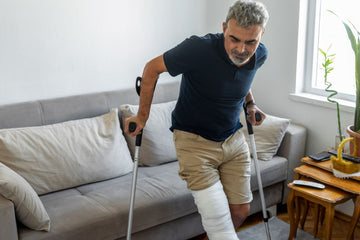Joint pain is one of those quiet companions that sneaks up on many of us. Whether it’s the stiffness in your knees after a long day, the aching in your fingers during colder months, or that twinge in your hips when you get up from the couch — joint discomfort can feel like it's slowly rewriting the way we live. It doesn’t just affect how we move; it affects how we feel about moving.
And while there are many pharmaceutical options available, not everyone wants to jump straight into medication. In fact, more and more people are turning toward natural remedies and lifestyle adjustments — not just for relief, but for the empowerment that comes with understanding your body and nurturing it in a way that feels right.
In this post, we’ll explore natural relief options for joint pain that are rooted in science, supported by tradition, and — most importantly — designed to be gentle yet effective. Whether you’re looking for simple tools to keep at home, daily habits to incorporate into your routine, or time-tested practices with a modern twist, there’s something here for you.
Understanding Joint Pain: More Than Just “Getting Older”
Joint pain isn’t just a symptom of aging — although yes, our joints do wear over time. It can stem from a variety of causes, including:
Inflammation from conditions like arthritis or gout
Overuse or injury, such as strains or sprains
Sedentary lifestyle, which weakens muscles and reduces joint lubrication
Poor posture, leading to uneven pressure on the joints
Weather-related sensitivity, which some people experience with humidity or cold
It’s helpful to identify the root cause of your joint discomfort. That way, the relief strategies you choose can work with your body, not just mask the symptoms.
What Really Helps? Natural Relief Methods That Make Sense
Let’s get into the good stuff — things you can actually do, use, or change to feel better. Here are some of the most effective natural ways to support your joints and reduce discomfort:
1. Heat and Cold Therapy: Simple and Effective
One of the oldest and most accessible forms of joint pain relief is temperature therapy.
Heat therapy (like warm compresses or heating pads) increases blood flow and helps relax tense muscles and stiff joints.
Cold therapy (such as ice packs or cold wraps) helps reduce inflammation, numb sharp pain, and slow nerve activity.
🧊 A product worth exploring: Reusable Gel Cold Ice Pack — great for wrapping around knees, shoulders, or elbows after activity. It molds to the body and can be used hot or cold depending on your need. Bonus: It’s reusable and easy to store in your freezer or microwave.
2. Low-Impact Movement: Gentle Strength is Your Friend
Movement might feel counterintuitive when you’re in pain, but staying still can actually make joint pain worse over time. Regular, gentle movement helps lubricate joints, strengthen the muscles around them, and keep stiffness at bay.
Some great low-impact routines include:
Stretching or yoga to enhance flexibility
Water aerobics or swimming for resistance without pressure
Balance exercises to stabilize joints and prevent falls
Strength training (light and controlled) to protect joints
💪 Pro tip: Consider integrating tools like the Elastic Rubber Resistance Band Set into your routine. These bands offer a range of tension levels to accommodate any stage of mobility, making strengthening and stretching accessible from your living room.
3. Anti-Inflammatory Foods: Fuel That Heals
What you eat can have a powerful impact on your joints. An anti-inflammatory diet may help reduce chronic joint pain over time. Foods that are especially helpful include:
Omega-3-rich fish like salmon and mackerel
Leafy greens, sweet potatoes, and berries
Turmeric and ginger, which have natural anti-inflammatory properties
Nuts and seeds, especially walnuts and flaxseeds
Try reducing sugar and highly processed foods, which can contribute to systemic inflammation — a key trigger in many joint conditions.
4. Aromatherapy & Stress Management: The Mind-Body Link
Stress tightens the body, disrupts sleep, and can even amplify pain signals. By calming the nervous system, you can support your joints indirectly. Aromatherapy is a beautifully gentle way to shift into relaxation mode.
Scents like lavender, eucalyptus, peppermint, and frankincense are known for their calming and anti-inflammatory properties.
🌿 A calming boost: The Aromatherapy Essential Oil Diffuser paired with a Premium Essential Oil Set can turn your living space into a mini sanctuary. Think warm baths, gentle stretching, and a scent that helps your muscles (and mind) let go.
5. Supportive Sleep and Sitting Habits
Your joints need downtime — but also the right kind of downtime. When you sleep or sit in misaligned positions, it can put extra strain on pressure points like the hips, knees, and spine.
Use supportive pillows to align your body properly during sleep
Opt for chairs that promote good posture
Take breaks to stand or stretch if you sit for long periods
Even something as simple as a Memory Foam Knee Pillow or Ergonomic Lumbar Support Pillow can make a massive difference in joint comfort during rest.
Conclusion: Relief That Respects Your Body
Finding relief for joint pain doesn’t have to mean surrendering to prescriptions, enduring side effects, or pushing through the pain. Natural remedies offer a more nurturing path — one that often requires patience but rewards you with a deeper connection to your body.
The beauty of natural approaches is that they’re rarely one-size-fits-all. You get to experiment, listen to your body, and find your own rhythm. Maybe it's the morning ritual of stretching, the comfort of a warm compress at night, or the calming scent of eucalyptus during your downtime.
You deserve to move through your days with ease, to wake up without dread, and to reclaim the joy of motion. Your joints are talking — and with the right care, they just might thank you with every step.








